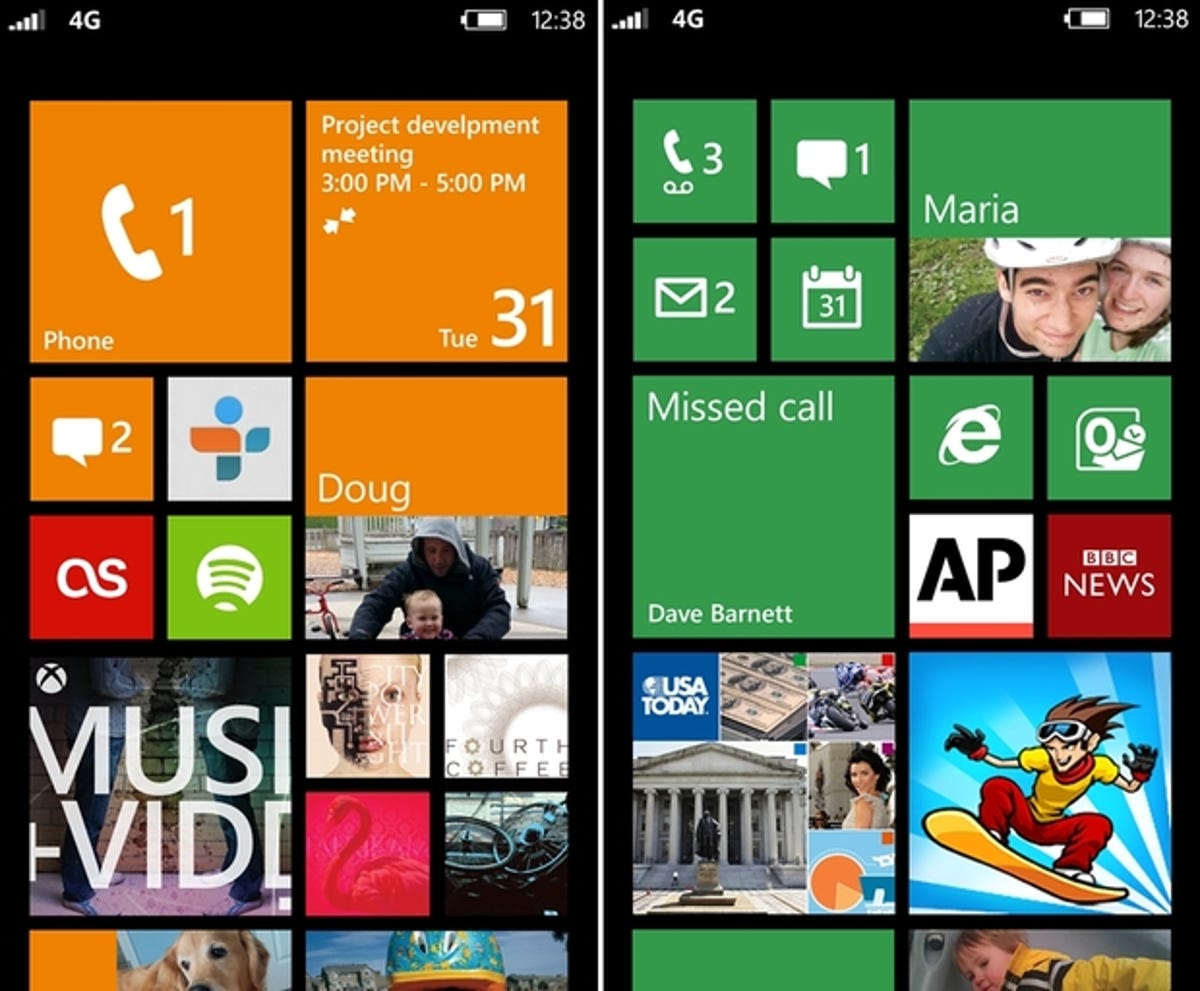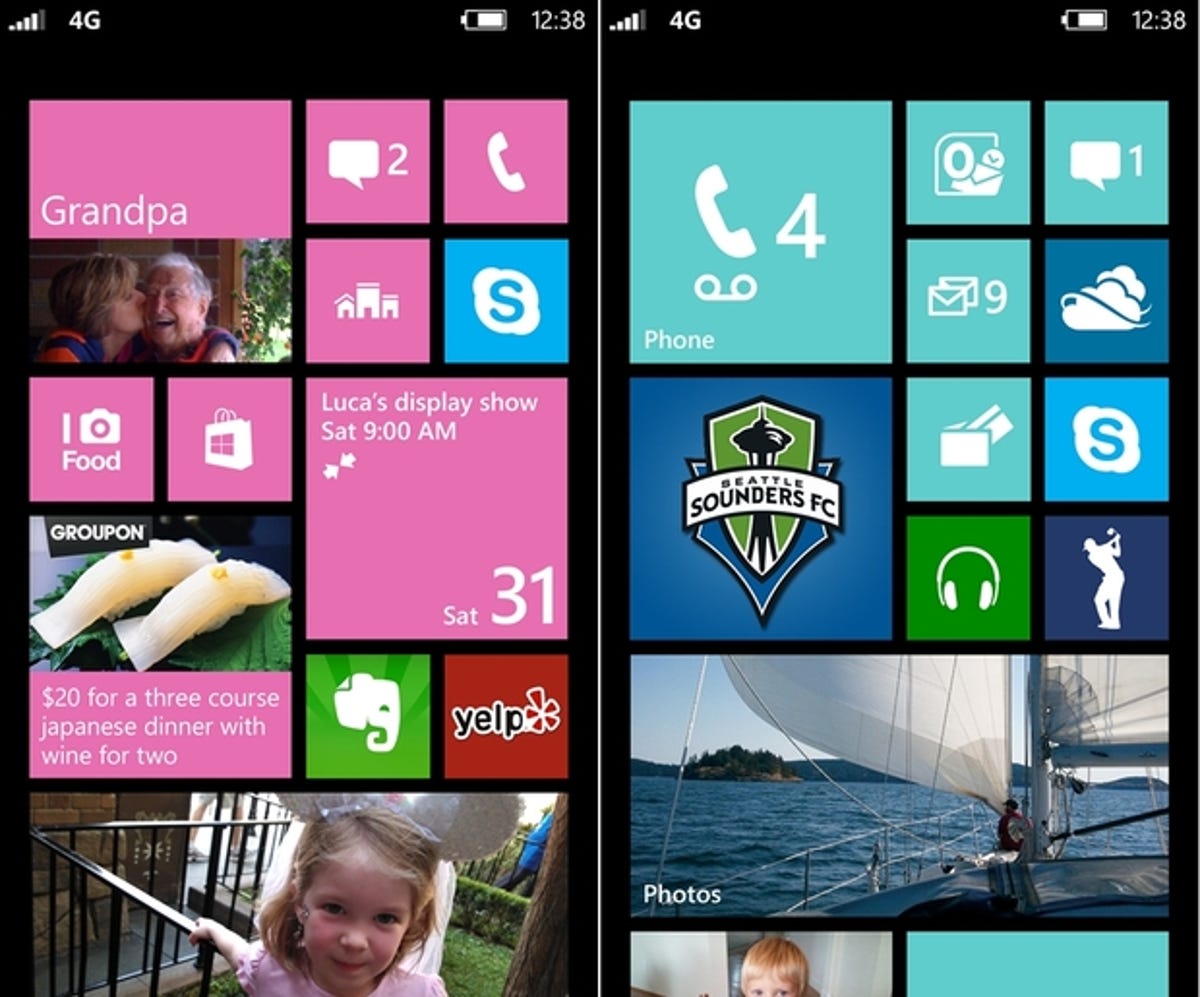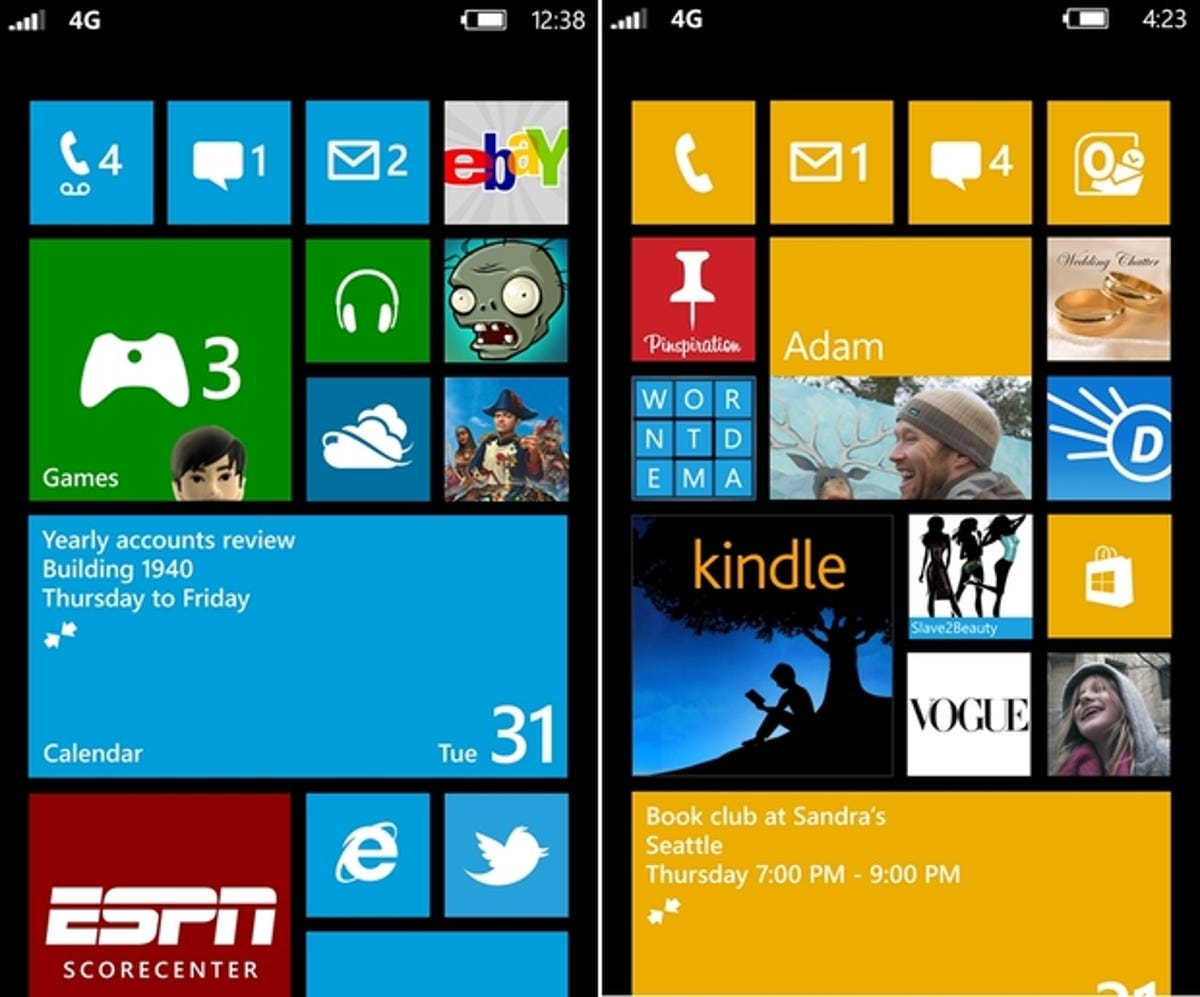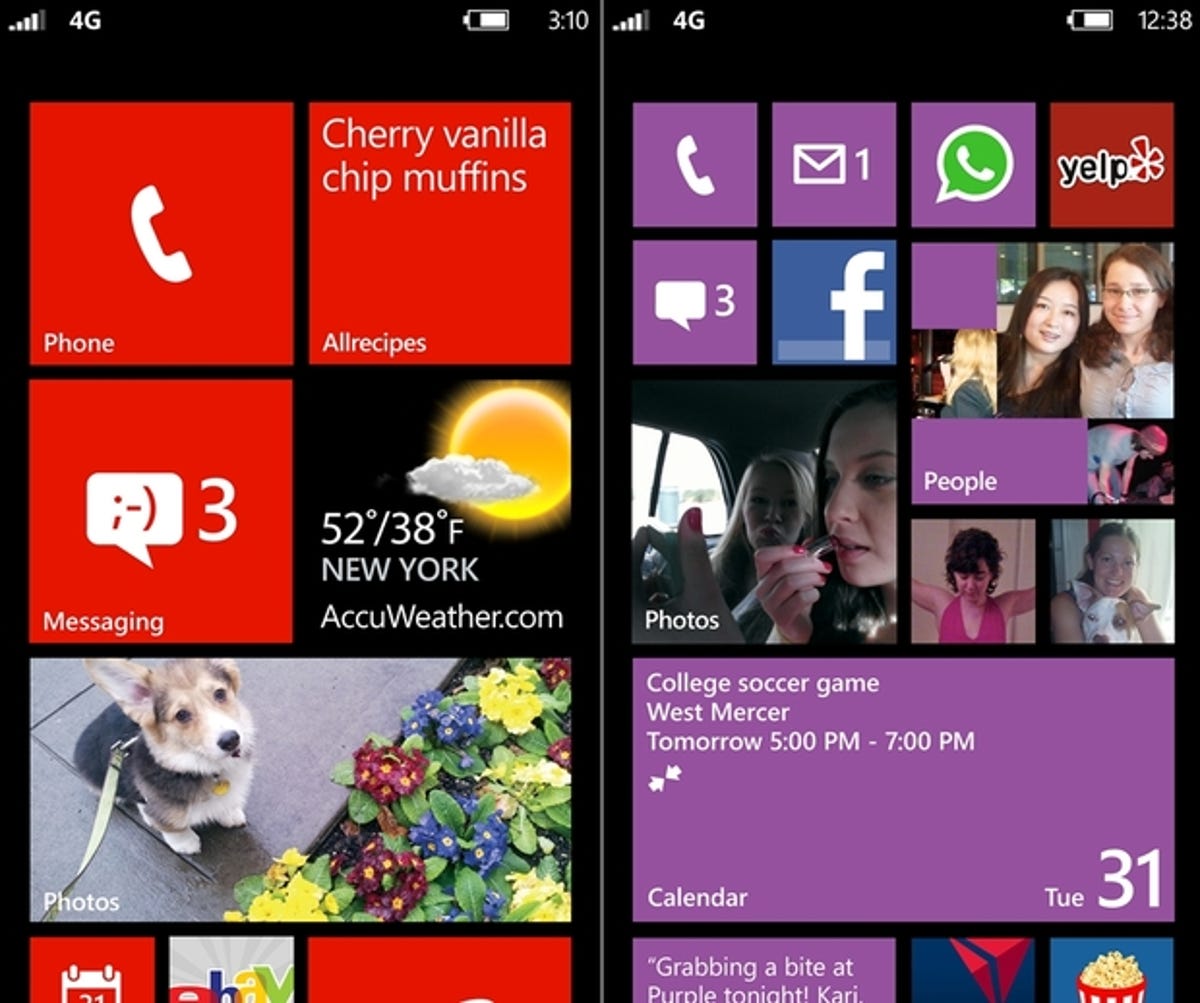
Microsoft’s consolation prize to anyone who owns a current Windows Phone is a new homescreen landing in an update known as Windows Phone 7.8, pictured above running on the Nokia Lumia 900.
It’s best described as a sweetener to coat the bitter truth that anyone who’s shelled out for a Windows Phone in the last 20 months isn’t getting the big upgrade to Windows Phone 8. Bitter because Microsoft knew this schism was coming all along but kept Windows Phone buyers in the dark.
Instead of iterating the Windows Phone software, Windows Phone 8 is a clean break with Windows Phone 7, which launched in autumn 2010. It’s a reboot of a reboot, with a completely different kernel and no forward compatibility for apps. The shared look of the two OSes is just that: surface similarity. Windows Phone 8 is based on the same software core as the next generation of Microsoft’s desktop OS, Windows 8.
If you own one of the Lumia Windows Phones, made by Nokia, the Finnish mobile maker has said it will bring some ‘visual enhancements’ and app updates to its current Lumia line-up — the ones that are being cut off from Windows 8. But the wider point about app compatibility is that any apps built specifically for Windows Phone 8 won’t run on 7.8 devices.
So anyone with a Windows Phone in their pocket now will miss out on the next wave of Windows Phone apps — while anyone who buys a Windows Phone 8 handset will enjoy all existing and future apps.
I recently argued that with this schism Microsoft has sucker-punched the fans Windows Phone has gained in the 20 or so months since it launched by locking them out of the platform’s future. It’s true that no technology lasts forever, but Windows Phone is still a newcomer, so having a radical reboot after such a small space of time risks taking the wind out of what are barely unfurled sails.
Gutted from the get-go
Yet according to Greg Sullivan, senior product manager for Windows Phone, Microsoft knew all along it would be orphaning Windows Phone 7. Asked when it started developing Windows Phone 8, he reveals development work was going on in parallel with Windows Phone 7 — and even earlier.
“It was right after Windows Phone 7,” Sullivan said, speaking in an exclusive interview with CNET UK. The team that developed the 7.5 release actually was working in parallel with the core team that was already beginning [Windows Phone 8]. In fact some of that work was already initiated before Windows Phone 7 was even available — so this goes back a little bit.”
Unifying the Windows Phone and full-fat Windows kernel “was always the plan”, he adds.


He refers to this Windows 7 to 8 schism as a “generational shift”. “Once in a while there are these generational shifts in a platform and sometimes companies do it in a way that doesn’t bring along any of the existing users… we’ve tried to do it in a way that really continues the momentum for the platform from a developer standpoint and that continues to bring new value to existing customers,” he says.
“It is true that this is a generational shift — that is a rare occurrence, but it’s something we don’t expect to have happen again in the foreseeable future because of the headspace that the new architecture gives us.”
Sullivan points out that existing Windows Phone devices will still be able to benefit from updates to the various services that underpin Microsoft’s mobile platform — such as its SkyDrive cloud storage, the Xbox Live service, Bing search, maps and so on — even if they won’t be able to integrate with its next generation of desktop software, Windows 8, in whatever ways Windows Phone 8 will be able to.
Windows Phone 8 and Windows 8 means ‘cool stuff’
Microsoft hasn’t given many examples of this coming Windows Phone 8 and Windows 8 “synergy” — as Sullivan puts it — beyond NFC-enabled features such as tapping one device against another to start a game. But he hints that there will be “cool stuff” to come.
“There are a whole series of… new capabilities and features that will come that we haven’t talked about and there’s integration with Windows 8 that we’ll demo closer to the date,” he says.
Whatever these new capabilities, features and “synergies” are, anyone who owns a Windows Phone today won’t be getting them without buying new hardware.
Of course, there are some new features that existing Windows Phone hardware would never have got via a software update because they require superior hardware — such as Windows Phone 8’s support for multi-core chipsets, higher screen resolutions, NFC technology and user-expandable storage.
“A lot of the work in Windows Phone 8 is related to the latest generation of hardware — and so having multi-core support on an existing single core device it can’t exploit that,” says Sullivan. “If you think about the 800×480 screen [Windows Phone 7/7.5/7.8 devices have] today — a couple of years ago that was a high-end screen, now it’s actually our low-end screen going forward.


“One of the things that [Windows Phone 8] does is it’s really an investment that sets us up for the very long term,” he continues. “In terms of the fundamental headspace that the architecture has, the room to grow. The architecture’s the same software that runs huge datacentres. All of the servers that manage petabytes of data for Bing utilise this OS architecture that will now be on your phone, so from scaling upwards to significant huge online transaction processing with 64 cores per virtual machine in these clusters of servers that do really really big computing, the identical architecture is now in your pocket.
“That’s a significant development that will give us a lot of room to grow over the years and so it will be a long time before we have another such generational shift.
“Our existing single-core phones compete very, very favourably with existing multi-core devices in the marketplace today. And the Lumia 900 is a fantastic phone that will continue to get better over the coming months and I think the folks that have one are generally very happy with that,” Sullivan adds.
Windows Phone 7 — doomed by design
With Windows Phone 7 having such a brief lifespan, it begs the question why did Microsoft bother with it at all — why not launch right off with Window Phone 8?
The simple truth is it couldn’t afford to wait that long. It needed to get a rung on the ladder to ensure a chance of catching up with Android and iOS.
In other words, it needed people to start buying into Windows Phone to make it worth developers’ time and effort to make apps for the platform — apps needed to convince more people to buy Windows Phones in future.
“It was important for us to establish this new approach in user experience and begin to build the developer ecosystem,” says Sullivan. “Those are necessary but not sufficient steps to establish a new platform and we didn’t want to wait until [we were able to launch Windows Phone 8] to begin that because we’re maintaining those core characteristics of the platform.
“[Windows Phone 7 has] been an important part of our mobile strategy,” he says. “It’s this new user paradigm, with the Metro style and design language, and the new app platform, which we also announced last week has 100,000 apps, which is a very significant milestone in terms of the platform’s critical mass.
“We’re at a point now where we have operator relationships, we’ve begun to establish the different approach in user experience that we take, we now have a critical mass of apps… and [Windows Phone 8] is not a start over — this is an extension of that.
“We knew that we would be moving to this architecture which is why we had the application platform approach that we had — so that all those apps would continue to run.”
If Microsoft knew it would be shifting its kernel, did it at least consider telling Windows Phone fans that this would be happening sooner than it has told them? Windows Phones such as the Nokia Lumia 900 are but a few months old and some buyers might have preferred to wait for a Windows Phone 8 device.


“It’s interesting because I got asked today why did we talk so soon about it — why did we talk so far in advance?” says Sullivan. “The reality of it is those of us who are in this industry and know exactly what version number of OS or update build number we have on are phone are different than the rest of the population. We’re special. We gadget nerds are special and we really care deeply about every piece of the technology we use and understand it at a pretty deep level.
“If you look at the Android install base, for example, the average person doesn’t know what version of the OS is installed on their device. Even if you look at Android’s marketing, it’s kind of the phone for people who think it would be cool to turn into a robot. Not everybody thinks that would be cool.
“And to regular people the idea of recompiling your kernel doesn’t sound like a fun way to spend an afternoon, but some of us are special… The idea is that updates are very important to a very influential and passionate subset of the user base… The overwhelming majority of Android users do not upgrade — mostly because they’re not given the ability to do so and even when they are, often they don’t.
“So we have a generational shift in our platform. We are doing it as part of an intended sequence of events in bringing Windows Phone to the market. It’s deliberate and I think that’s evidenced by the care we’ve shown in that apps will continue to run, the investment in apps will be maintained, and that the key parts of the user experience we’ve developed will come back to existing users, so we think this is really the best approach that has enabled us to deliver the meaningful set of values that is going to be relevant on existing hardware and at the same time taking full advantage of new hardware.”
Microsoft wants the middle of the mobile road
So what’s the idea behind the homescreen redesign? “What we heard is that users wanted to make the homescreen even more their own,” says Sullivan. “And the ability to control the tile size does that. They wanted to see more at once, so using the whole screen does that and then they also wanted more theme colours.”
The result appears like a very orderly Android homescreen, with large
tiles that are effectively widgets, positioned next to smaller tiles
(also widget-esque) and tiles so small they are effectively icons,
because they display only very basic updates such as the number of
unread emails in your inbox.
Windows Phone owners can currently choose from 10 colours of tiles displayed on either a black or a white background.
“There will be a few more colours,” says Sullivan, hinting through choice of words that the number of extra shades won’t be humungous. Also don’t expect to be able to wallpaper Windows Phone 8 devices with patterns. Paisley or tartan lovers are out of luck — Microsoft remains wedded to Windows Phone’s distinctive, solid blocks of colour.
“There’s a fine line between too much ability to customise and [not enough],” says Sullivan. “We’re usually very good at that at Microsoft — let’s expose all of the dials and levers to you and see how infinitely customisable we are, but that is not always the best approach.”
Being too controlling isn’t good either though, says Sullivan, making a dig at the iPhone — he reckons any two iPhone owners’ homescreens are more similar than he is to his identical twin brother.
“Today I would argue Windows Phone with our live tiles does a better job of accurately reflecting and presenting the things you care about,” he says. “I have an identical twin brother and we are genetically clones but my start screen and his are vastly different because… our lives are different, we’re different people.
“I would argue that if you went out on the street and picked two people who use the iPhone their phones would look more similar than me and my twin brother.”
The Windows Phone philosophy is to take a middle road, says Sullivan, between the tightly controlled and thus more limiting approach of Apple with its iPhone, and the sometimes chaotic but nonetheless liberated free-for-all of Google’s Android OS.


Windows Phones come in a variety of form factors but the OS has the same look and feel on all of them.
“Apple you have one choice of hardware. Android you have an overwhelming degree of choice — some of which don’t necessarily provide the best of breed user experience,” says Sullivan. “[With Windows Phone] you get the benefits of the vertical model in consistency of user experience and the benefits of choice of the horizontal model in hardware and form factor. That’s but one dimension where we’ve tried to achieve that.”
Of course merely offering a handful of hardware choices and having a homescreen that displays app icons hasn’t stopped Apple selling truckloads of its i-Devices — millions and millions more than Windows Phones have been flogged. Microsoft’s share of the smart phone market in the first quarter of this year was pegged by analyst house Gartner at just 1.9 per cent — a figure that incorporates sales of its previous OS, Windows Mobile, as well as Windows Phones. (Apple’s share was 22.9 per cent.)
Nor has Android’s rich biodiversity of hardware and software choice stopped a veritable army of Androids marching into people’s pockets — Gartner calculates its share at 56.1 per cent for Q1 this year. And all the while Windows Phone remains so far behind Android and iOS even Meatloaf wouldn’t think it looks any closer than it is.
Windows Phone 8 hardware — choice but not too much
Microsoft hasn’t yet announced the hardware specifications for Windows Phone 8 devices but, discussing new hardware, Sullivan says Windows Phone 8 will include both high-end and mid-range smart phones — hinting that it’s unlikely to push too far down to the very budget end of the smart phone spectrum.
Although he also notes that one way to allow cheaper Windows Phone 8 devices to creep into the market would be to utilise the new features of support for user expandable storage and support for different screen resolutions.
“One of the things that several screen resolutions and user expandable storage will do is that if you think about the 800×480 screen today… if you add to that a device with a minimal amount of storage built in initially to lower the building materials and the cost of the phone, but have it be end user expandable then you can maintain an offering in that lower price band or at least in that mid-range, so I think we’ll continue to have a broad range of offerings from the high end through the mid-range,” he says.
Even though there will be a handful of new screen resolutions, Sullivan stresses Microsoft’s plan with Windows Phone 8 is not to loosen its grip and open up “a huge spectrum” of pixel-density choice.
“That’s by design. We don’t want to be Android. The fragmentation associated with having multiple screen resolutions and primarily aspect ratios… we really wanted to minimise any impact so we’re very deliberate. Today we have a 15:9 aspect ratio — WVGA — and we’re adding another 15:9 and a 16:9 so our aspect ratios are very close. And in the case where they’re not identical, the system is going to do some scaling so apps will just work.
“If you as a developer want to maximise every pixel of resolution you have the ability to do that but you can have one binary that runs across all screen resolutions and the system will scale up accordingly,” says Sullivan. “That’s an important balance — we want to support things like 720p to support hi-def screens but we want to do so in a way that presents a consistent platform for developers.”
Microsoft’s view is that too much choice hurts a platform in the long run — something it learned from its earlier mobile effort, Windows Mobile, says Sullivan.
“Over the long term [fragmentation style] challenges make it more difficult for a platform to maintain momentum,” he says. “We had that approach with Windows Mobile, frankly — the hardware manufacturers could put it on a wide range of devices even some at what I’ll call the low end of the power curve and I think you’ve seen the same thing today with Android and the result is inconsistent user experience, inconsistent developer platform, inconsistent user experience at a very high level — it just looks and interacts with completely differently — and so it really gets challenging once that complexity reaches a certain degree which I would argue it kind of has [with Android].
“So we want to provide flexibility for [manufacturers] to build new types of screens and have new resolutions and maintain the consistency of the platform.”
HTC, Huawei, Nokia and Samsung have already been outed as planning to stamp their names on Windows Phone 8 hardware, but Sullivan suggests Microsoft is hopeful some more mobile makers will sign up soon.
“We obviously have relationships with many manufacturers and will probably have more announcements to make as we get towards launch,” he says.
Asked whether we’ll be seeing Nokia’s exceptional camera phone technology — just launched on the Symbian-based 808 PureView — on the Windows Phone 8 platform, Sullivan says: “That’s the hope.”



